-
Posts
6,486 -
Joined
-
Last visited
-
Days Won
9
Content Type
Profiles
Forums
Blogs
Gallery
Events
Store
Posts posted by Brian Wolfe
-
-
Hi Ralph,
Wow! That's a great collection.
Thanks for sharing.
Cheers

Brian
0 -
Hello fellow members,
Here is a LSGC medal that I picked up several years ago. From the two holes near the hanger it would look as if this has not always been with the present hanger. The hanger looks correct but the two hole are one of the mysteries of this medal. The swivel attachment of this piece has been replaced by a small bolt! The recipient's name has been polished off, or nearly so. what I can make out is the following, "408 Qt. Mr.Sergeant,(area where the name would have been), N. Staff. R. (North Staffordshire Reg.?)
Why anyone would only partially remove the lettering is a mystery to me. I was able to pick this one up at a pretty good price as the name had been removed. Still it is to a Quarter Master Sergeant and perhaps some day I will be able to trace the original owner through his number and regiment and it is in pretty good condition.
The reverse is the usual, "For Long Service and Good Conduct".
Cheers
Brian
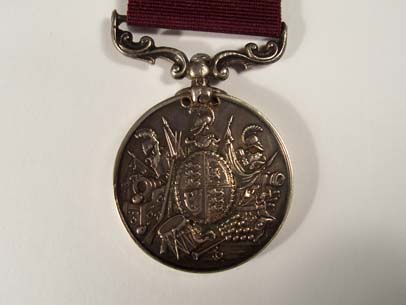
 0
0 -
Here is the one my father brought back from Burma in 1945. He told me that most the stains were human blood!
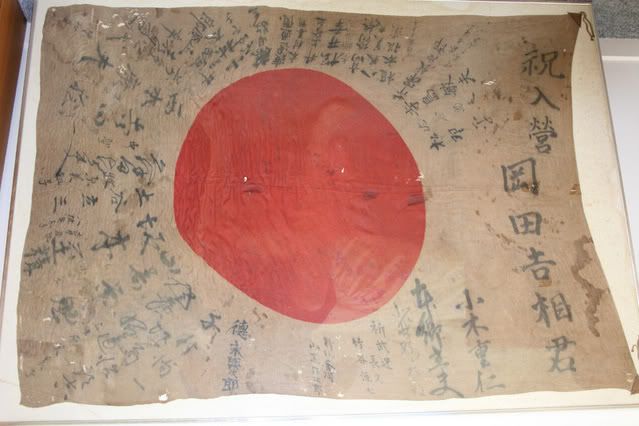
Along with the cash that they removed from dead Japs.

Hi 'jonightflyer
Nice Japanese flag, I think you have it up side down though. Since each soldier would get his flag signed by his own friends or perhaps his priest each flag becomes an individual piece of art. I believe the stains on my flag are caused by sweat rather than blood.
Cheers

Brian
0 -
Brian,
I Love your flag! The more Kanji in my book the better. It looks great framed as well. I started to slowly collect more and more Japanese Militaria over the years and have grown to appreciate it more and more. Right now, the only flag currently, that I own is an Imperial Army Rayed Flag.
Regards,
Joel
Hi Joel,
I have some Japanese swords that I will be posting at a later date. A couple date to the 1650s but most are WW II. They go well with the flags (I also have the Imperial Army rayed flag but not framed).
Thanks for your comments.
Cheers

Brian
0 -
Hello All,
Here is my Imperial Japanese flag that has been covered in Kanji messages. The flag measures 32 inches in lenght and 26 inches in width and is silk. I have tried to figure out what has been written on the flag and all I have so far is the large symbols along the top figured out. Basically it is a wish for as long and shinning career in the military. The other writings I am told are similar in content. The styles of Kanji include formal, flowing and stylish.
I have been told that young Japanese soldiers would purchase these flags and then have well- wishers sign them for luck. Because the helmets of the day had very poor padding these flags were often folded and stored in the helmet both for luck and added comfort. This may not be fact but that was what I have been told.
I had to photograph the flag from an angle as my beer fridge and I were in the photo when I took it straight on.
Cheers
Brian
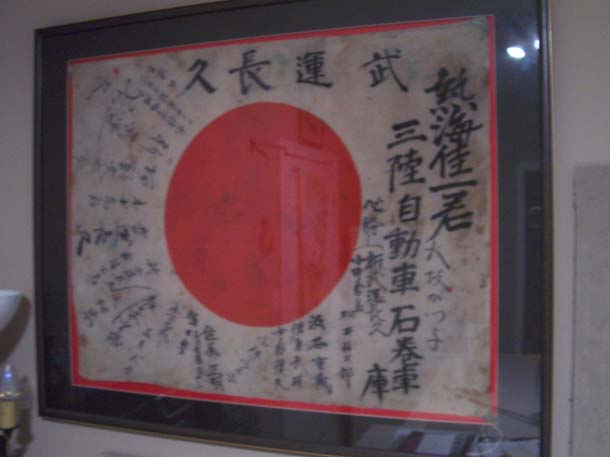
 0
0 -
My 19th c. Royal Nepalese Army one is 19in. overall and hand forged. The WWI & II models as I remember were only slightly shorter, maybe an inch. I think you've got a real winner. Do you have the sheath and the 2 small knives?
Hi Tom,
No the dealer who was selling perhaps a dozen or more at the time only had the knives to offer.
Cheers
Brian
0 -
Far, FAR from anything I know much about, but it looks pre-WWII to me, probably WWI (if I had to GUESS).
Hi Ed,
It didn't look like the ones I've seen from the WW II period. If you run your fingers along the fullers it feels slightly wavy as if there are hand forged marks left on the blade. These are slight but you can feel them.
Cheers
Brian
0 -
I'm hardly an expert, but from the wide pommel and lack of markings I doubt if it's military, and probably pre-1900. How long is it?
Hi Tom,
The whole knife is 16 1/4 inches in length with the blade being 11 1/2 inches.
Cheers
Brian
0 -
Hello All,
I had a couple of Kukri knives that I purched several years ago and I was wondering if anyone would happen to know the age of the one I still have. I traded the other kukri for the Afganistan 1881 medal I posted photos of earlier this evening. It was a good trade as when I purchased these they were selling for $25 - $30 each depending on the condition. This one has two "fullers" running down the blade, I would guess for added strength and to lighten the massive blade. There are no markings on this weapon to denote government ownership. Any ideas as to age?
Cheers
Brian
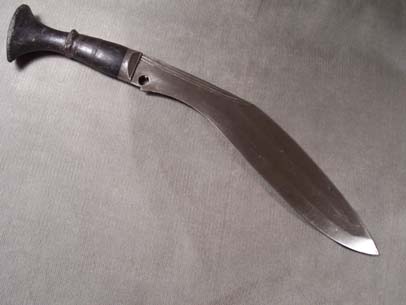

 0
0 -
Hello All,
I sent the reverse of this medal by mistake. Here is the obverse of the Afganistan 1881 medal to 1598 Pte. G. Burch, 8 Bde/158 51st Regt.
I really do like the reverse of these older medals, I guess that's why I send the reverse first.

Cheers
Brian
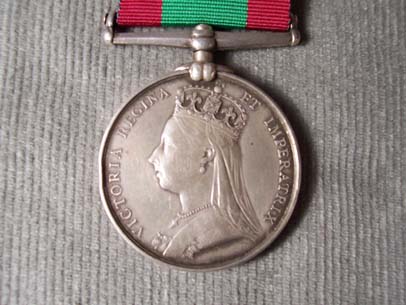

 0
0 -
Hello All,
I want to show off my Afganistan 1881 medal named to 1598 Pte. G. Burch, 8Bde/158, 51st Regt. that I got in trade for a kukri last year.
Cheers
Brian


 0
0 -
Hello fellows,
The sword hilt was broken off by the farmer's plough (a.k.a. plow) and was lost before I owned it. I hope this shows up in the photos. The tip does not appear to be shortened or if it was it was done by someone who knew what they were doing as the fuller tapers out short of the tip. I would think that if it were shortened the fuller would extend all the way to the tip much like the WW I British bayonets that were shortened as trench fighting knives. I have a Japanese sword c.1650 that was shortened and until I was shown that the hamon when through to the tip I was not aware it had been shortened. So, I could be wrong about this one as well. I have used a pencil in the photo to indicate where the fuller stops.
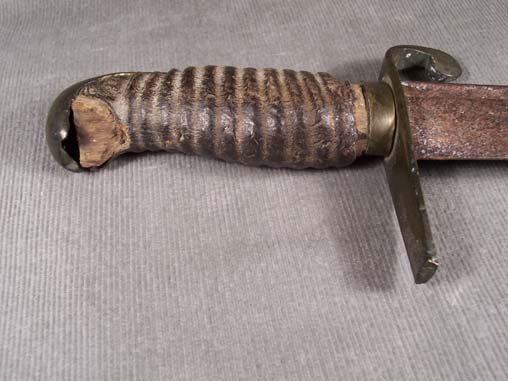
 0
0 -
That makes a lot of sense, because otherwise that is a VERY strange handguard - only half there - but as a cutdown basket or stirrup hilt it looks "right", if I'm making sense.
Peter
Hello fellows,
The sword hilt was broken off by the farmer's plough (a.k.a. plow) and was lost before I owned it. I hope this shows up in the photos. The tip does not appear to be shortened or if it was it was done by someone who knew what they were doing as the fuller tapers out short of the tip. I would think that if it were shortened the fuller would extend all the way to the tip much like the WW I British bayonets that were shortened as trench fighting knives. I have a Japanese sword c.1650 that was shortened and until I was shown that the hamon when through to the tip I was not aware it had been shortened. So, I could be wrong about this one as well. I have used a pencil in the photo to indicate where the fuller stops.
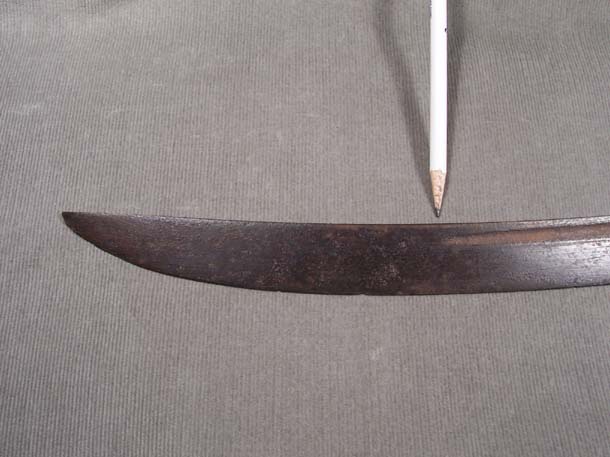
 0
0 -
Well, as is usually the case, it depends entirely on who you ask.
They might have been Irish Freedom Fighters, attempting to liberate Canada from the Yoke of English Oppression.
They might have been American Terrorists.
Other possibilities exist.

Hello Ed,
In our family we always referred to them as "our Irish cousins". We had family on both sides of the boarder and still do. I like to think of them as Freedom Fighters at least in their own minds. If my cousins were indeed terrorists of their day they are American tourists today.

Cheers and a tip 'o' the hat to you.
Brian
0 -
Brian,
Would you happen to know of any individuals that might have militia lists/rolls for that era? The reason I ask, and in keeping with the topic, is that my great Great Grandfather was an officer in the Nova Scotia Militia, who, from oral history, had partaken in the response to the Fenian Raids and possibly the North West Rebellion. However, the problem with the medal roll for the Fenian Raids was that they only include the names of the individuals who applied for the medal itself! The medal wasn?t handed out until 1901, by which time some of the participants had died. I?m trying to find out if the oral history is true and track down unit records, if possible. Any help out there??
Cheers,
James
Hello James,
Sorry, I only have the medal roll book. Perhaps a quick email to the National Archives in Ottawa would uncover some answers.
Cheers
Brian
0 -
How long is the blade? can you tell if it has been shortened? I ask because it looks much older to me, and if not cut down, I would suspect something like a naval cutlass rather than a cavalry hacker.
That is definitely something made for cleaving "meat" and not swanning about on parade.

Hello Rick,
The blade is 28 inches long and I do not believe is has been shortened. The fuller tapers out several inches from the tip. Going from what I have read this could very well be a naval sword as the Fenians were stock piling arms for some time before their "invasion" of Canada and they were purchasing these arms from many sources. A lot of the weapons had seen service in the American Civil War. If you need one any old hacker will do in a pinch.

Cheers
Brian
0 -
Hello all,
I have posted a couple of medals from the Fenian Raids era today and I wanted to wrap up by showing what I believe to be a sword used in the Battle of Pigeon Hill Quebec, Friday 8, June 1866. I purchased this over 40 years ago (I was a teenager) and I was told, after I made the purchase, that it was a battle field find from Pigeon Hill Quebec. I paid only $5.00 for it at the time and tagged it with the information and put it away. I was, at the time, caught up in collecting anything military and paid little attention to it until quite recently when my wife purchased a Fenian Raid 1866 medal as a gift for me. I have had quite a few swords and other militaria over the past 40 years come and go but always held onto this old rusty piece of history. I'm very happy that I did. I believe it to be a Fenian sword in that I don't recognize it as British. From what I have read the Fenians purchased weapons from many different suppliers. If anyone knows more about this type of sword from the basic shape please let me know. The hand guard is missing and the leather has peeled back from the wooden handle which shows evidence of rot from being in the ground. The blade is heavily rusted but has stabilized and I don't think any further damage will be done. The blade is 28 inches in length.
I posted this under Swords & Edged Weapons so that it would not be in conflict with the Medals section.
Cheers
Brian

 0
0 -
Hallo Brian,

Welcome to the Forum, I took the liberty of brightning up your picture, to show some detail

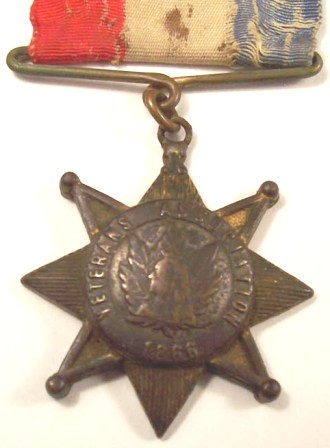
Kevin in Deva

Wow! That's great Kevin.

Many thanks
Cheers
Brian
1 -
Nice. Many thanks!!
More, more, more.

What is the naming? And which clasp?
Oops,
I was so excited about posting images I totally forgot to include the name and bar.

The medal is named to, Pte. J. HODGSON Como R. Co.
The bar is the Fenian Raid 1866.
Pte. Hodgson is listed in the book "Canada General Service Medal Roll 1866 - 70" by John R. Thyen (page 166).
Many thanks to Ed for pointing out my ommission.
Cheers
Brian
1 -
Hello,
Now that I have figured this photo thing out I am posting more of my limited Fenian Raid collection. OK, so my wife figured this out and wrote it down for me.

This is a bronze Veteran's Association medal dated 1866 so I though it fit quite well into this section of my collection. I took several photos and this is the best of the lot. Sorry it is not better. The medal has an image of Queen Victoria on a maple leaf with the wording Veteran's Association 1866 around the Queen's image. The reverse is not marked or named. The ribbon is quite fragile and I think original. The medal itself is very worn and I would expect that the veteran wore it with pride for many years. I feel that it fits in my Fenian Raid collection as what else would the Veteran's Association of 1866 have to talk about? That's a retorical question of course.
If anyone knows more about this item I would like to here back from you.
Cheers
Brian
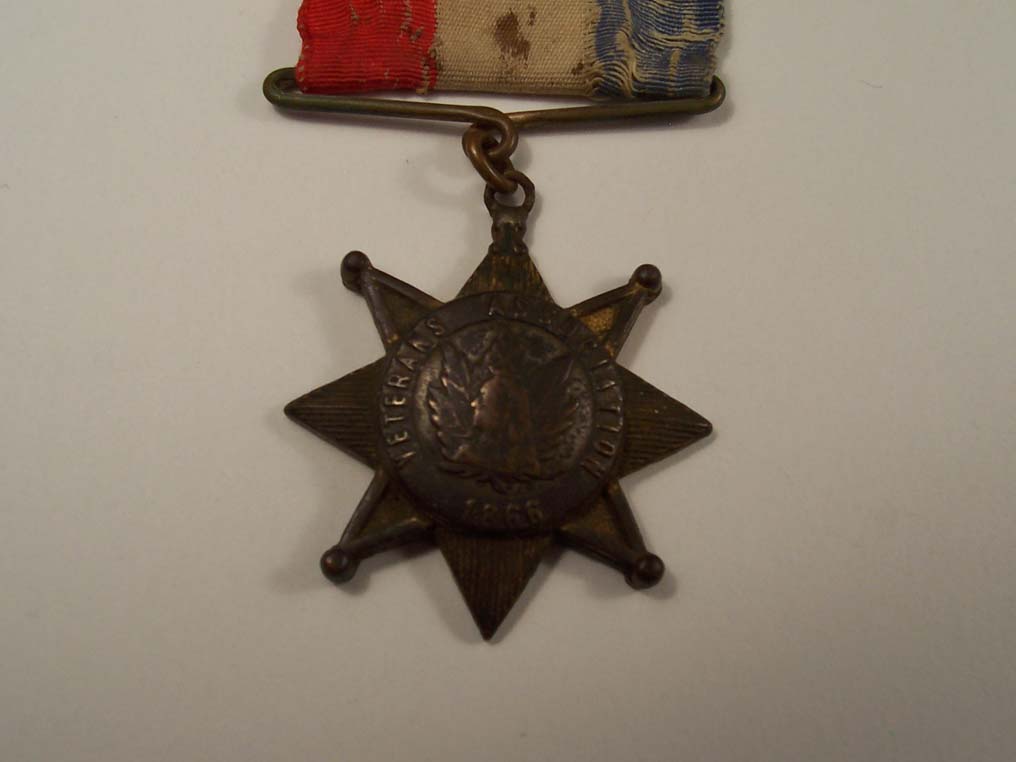

 1
1 -
Hello Chaps,
As my first attempt at a post with photos I have selected one of my favourite items from my small Fenian Raid collection. This was a medal that my wife purchased for me as a birthday present. At that time she paid $300.00 CDN for it so that gives you an idea of how long ago that was. I added the minerature medal a couple of years ago and it is a contemporary striking and cost as much as the full sized medal. I also have a Veterans Association medal dated 1866 and a battle field find sword found at Pigeon Hill Que. I will attempt to post those as well after I see if this post is successful.
I hope you like them.
Cheers
Brian
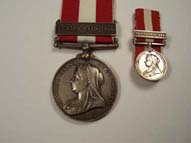
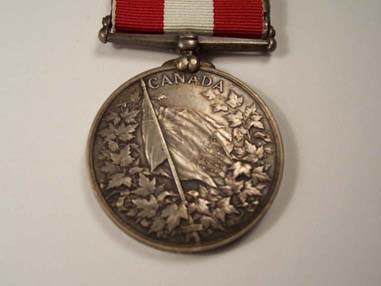



 1
1 -
Greeting all,
A fake in my collection!!!? Well, there goes the neighbourhood!
Now, anyone have any prime swamp land they want to sell me?

Many thanks to all who have helped to uncover this fraud.
Cheers
Brian
0 -
Hello fellows,
I'm sorry but my software will not allow me to post any photos at this time. I will have to play with this darn computer on the weekend to see if I can figure out the magic formula.
My pin is flat and it has the letters ARAD not AKAD. It has a pin on the back and the wording, HOFFSTATTOR/BONN around the top edge and CES CESCH along the bottom.
I agree with the consensus that 1944 was not the best of time for the Axis and further any join conferences would be unlikely. I've seen a lot of old artifacts and the one I have sure looks like it has been around since the time stated on the front (1944). There is a patina to it that would be very difficulr to artificially produce. I wonder if it was manufactured well in advance of the proposed conference that never took place. I am reminded of a British Service Corps collar dog I have with King Edward VIII on it.
I will keep trying to post photos of this pin, as frustrating as the exercise is to someone of advancing age.

Cheers
Brian
0 -
I just noticed that the word "AKAD" on the one in the photograph is "ARAD" on mine.
Cheers
Brian
0




My EK II Document
in Germany: All Eras: The Iron Cross
Posted
Hello All,
I am posting a photo of an EK II document from my collection. It is not all that great or showy but I purchased it because of the name. Our family originated in Germany and over the course of many years (going back hundreds of years) migrated back and forth between Germany and the UK. Somewhere along the way we changed the spelling of our name from Wolff to Wolfe. Most of the Wolfe side of the family was involved in the British military. The Wolff "group" settled in and around Belfast. This EK II was awarded to Fusl. Wolff. Not very likely a true relation but I liked it and now it lives with the rest of the collection.
The document says (pardon my poor German translation),
Identification Card, In the name of His Majesty the Emperor and King is the Fusilier Wolff second order the 12th Company Fusilier Regiment Prince Karl Anton von Hohenzollern (Honzollernsches) Unit number 40 on 18. 4. 1917 the Iron Cross II. Class is conferred and has been declared.
I have not been able to gain any knowledge on this unit or where they were on or around that date.
I hope you like it.
Cheers
Brian